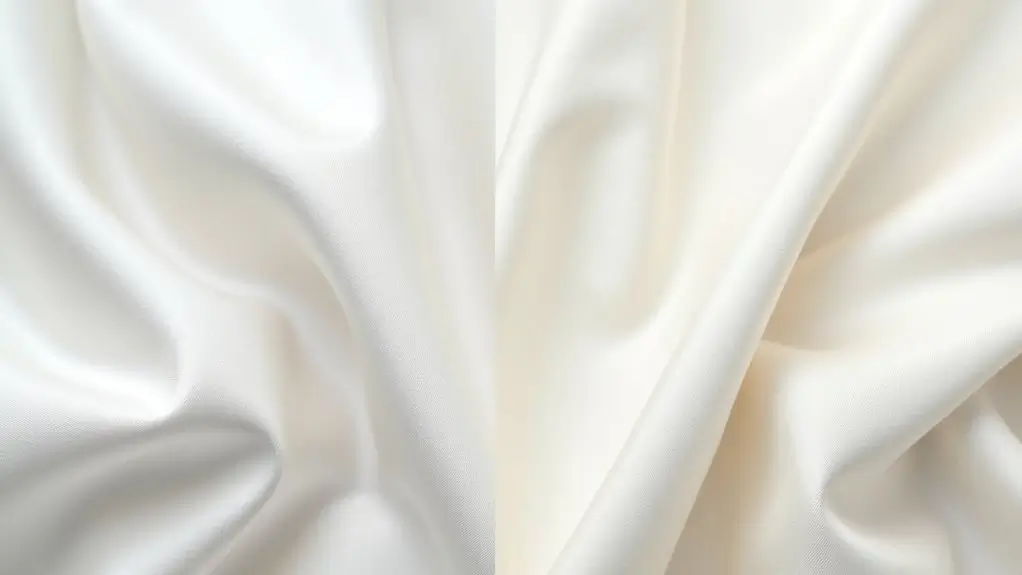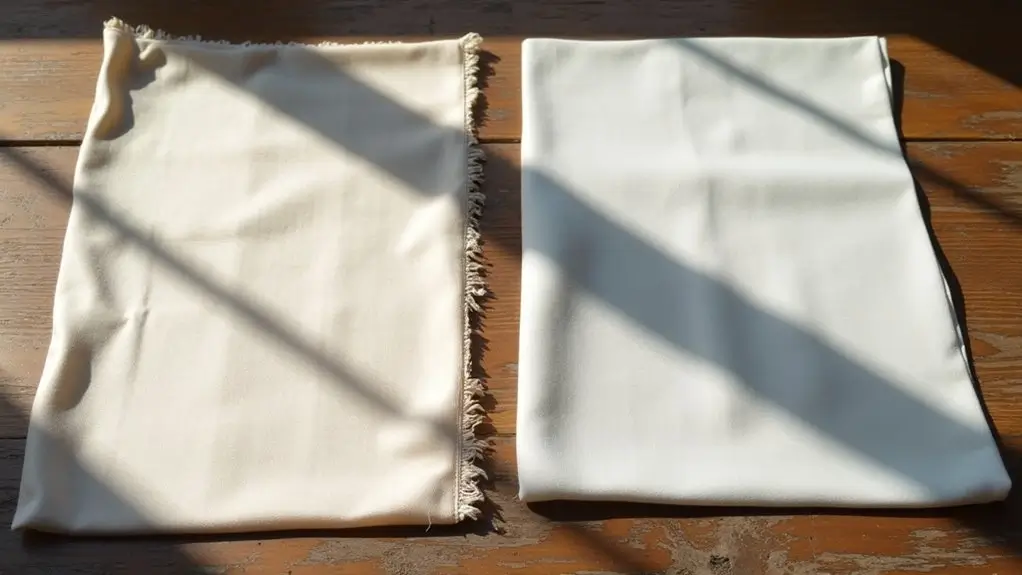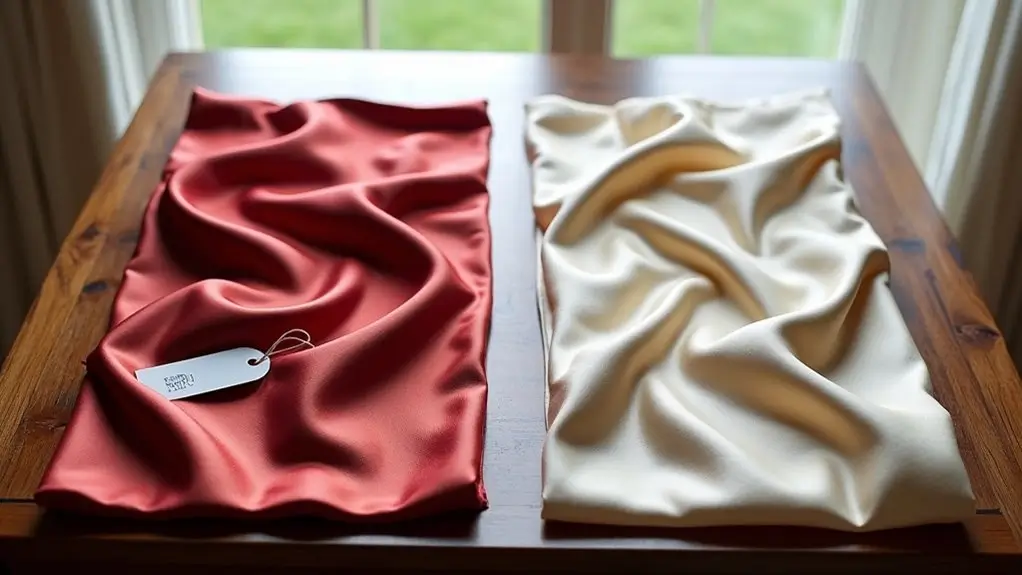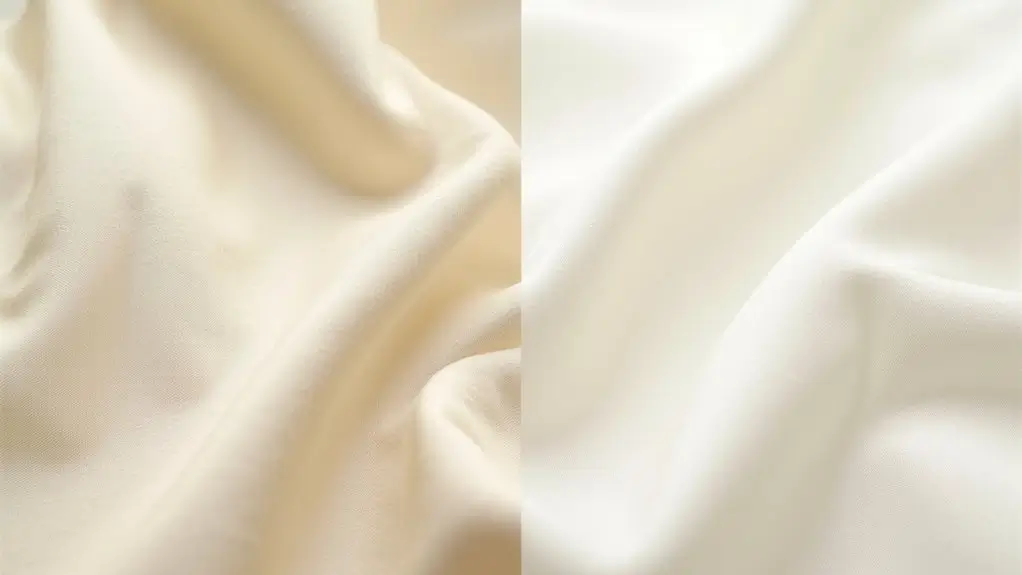When comparing satin and sateen, you'll find key differences in their weave patterns and fiber composition. Satin uses a warp-faced thread with silk or synthetic filaments. This creates its characteristic glossy surface. It's ideal for formal wear and special occasions.
In contrast, sateen uses a weft-faced weave made from cotton fibers. It offers better durability and easier maintenance for everyday items like bedding.
Understanding the differences between satin and sateen will help you make smarter fabric choices.
Key Takeaways
- Satin typically uses filament fibers like silk or polyester. Sateen is primarily made from cotton.
- Satin features a warp-faced weave, creating a high shine. Sateen uses a weft-faced weave, producing a softer luster.
- Satin requires delicate care with hand-washing or dry cleaning. Sateen is more durable and machine-washable.
- Satin is commonly used in formal wear and for special occasions. Sateen is perfect for everyday items like bedding.
What Is Satin? Origins and Manufacturing Process

The luxurious fabric known as satin first emerged in the 12th century. You can trace its origins to the ancient port city of Quanzhou, China.
Originally, satin was made from silk fibers exclusively. It earned its name from the Arabic word "Zayton," which refers to the port city where it was traded.
The unique satin weave creates a smooth, glossy surface on one side and a dull finish on the other.
You'll recognize satin fabric by its characteristic sheen. This is achieved when warp threads float over weft threads in a specific pattern.
Today's satin is defined not only by silk but also by synthetic materials that maintain its distinctive gleam.
Understanding Sateen: A Cotton Alternative

Satin boasts a rich silk heritage. In contrast, sateen emerged as a more practical alternative crafted primarily from cotton fibers.
This cotton sateen fabric is incredibly durable and suitable for everyday use. This is thanks to the unique sateen weave pattern that creates a softer feel than traditional cotton.
Since it's made from cotton, you can easily toss your sateen items into the washing machine without worry.
Its comfort and practicality make it an excellent choice for bedding, casual garments, and home textiles. It offers you both durability and a touch of luxury.
Key Material Differences Between Satin and Sateen

Material composition stands as the fundamental distinction between sateen and satin fabrics, shaping their unique characteristics and best uses. Satin is made from filament fibers like silk or nylon. But sateen is made primarily from cotton yarns.
| Feature | Satin | Sateen |
|---|---|---|
| Primary Fiber | Silk/Synthetic | Cotton |
| Type of Weave | Warp-faced | Weft-faced |
| Best Uses | Evening wear | Bedding |
The key difference in fiber type affects how each fabric performs. Satin's filament fibers create that signature high shine you'll recognize in formal gowns. But sateen sheets offer a more subtle luster that's perfect for everyday use.
Durability and Care Comparisons

Durability plays an essential role in fabric selection. You'll notice significant differences between satin and sateen in terms of wear and maintenance.
Satin's delicate nature requires special care. It often needs hand-washing or dry cleaning to maintain its lustrous finish.
Sateen, made primarily from cotton, offers superior durability and easier maintenance. You can machine wash your sateen fabrics without worry. This makes them perfect for everyday items like bedding and casual wear.
Satin's synthetic fibers make it prone to snags and pulls. But sateen's cotton composition helps it withstand regular use while maintaining its subtle sheen.
Cost Factors and Price Ranges

Understanding the price differences between sateen and satin can help you make cost-effective choices for your projects.
When choosing between satin and sateen, you'll find that fiber content greatly impacts the cost. High-end silk satin commands premium prices. But synthetic satin made from polyester or nylon offers more affordable options.
Cotton sateen sheets typically fall in the mid-range price category. They offer good value due to their durability and lower maintenance costs.
You'll save money in the long run with sateen's machine-washable nature. Instead, satin's delicate composition often requires costly dry cleaning and special care treatments.
Best Uses for Each Fabric Type

Both satin and sateen fabrics offer unique qualities. But each one shines in specific applications that maximize their strengths.
Satin's lustrous sheen is perfect for special occasion clothing. You can find it in like evening gowns, wedding dresses, and luxury accessories, where elegance is key.
Sateen's durability and cotton composition make it ideal for everyday use. You'll love it for bed sheets, pillowcases, and casual clothing. These require frequent washing and regular maintenance.
Sateen's softer sheen and comfortable feel work well in home décor items, too. You'll find it in curtains and upholstery where you need both style and practicality.
Satin vs Sateen: How to Make a Fabric Choice

Making the right choice between satin and sateen depends on how you plan to use the fabric. It also depends on what qualities matter most for your specific needs.
The key difference between the two lies in their durability and maintenance requirements.
- If you're creating formal wear or special occasion garments, choose satin for its elegant sheen and fluid drape.
- For bedding and everyday items, sateen is typically made stronger and easier to care for.
- Consider that satin is more delicate and often requires dry cleaning, especially when made from synthetic fibers.
- Sateen sheets use cotton fibers. They offer better durability and machine washability for regular use.
Conclusion
When you're deciding between satin and sateen, remember their distinct characteristics to make the best choice for your project. Satin's high-gloss finish works beautifully for evening wear and special occasions. Sateen's cotton construction makes it ideal for bedding and everyday garments.
Satin requires more delicate care, but sateen offers greater durability. Consider your specific needs, budget, and intended use to select the fabric that'll serve you best.
Learn more fabric knowledge on the Longan Craft Blog, and dive into the fabric world with Longan Craft!
FAQs
Can Satin or Sateen Fabrics Be Used for Outdoor Furniture Cushions?
No. They'll quickly deteriorate from sun exposure, moisture, and mildew. Instead, choose outdoor-specific fabrics like Sunbrella or polyester canvas.
Do Satin and Sateen Fabrics Pill Over Time With Regular Use?
Satin can pill, especially synthetic versions with regular friction. Sateen's cotton composition makes it more resistant to pilling. But it may still occur in high-friction areas with repeated use.
Which Fabric Is Better for People With Sensitive Skin Conditions?
For sensitive skin, sateen is a better choice. It's hypoallergenic, breathable, and made primarily from cotton. The fabric's smoother surface won't irritate your skin during regular contact or movement.
Are There Eco-Friendly or Sustainable Versions of Satin and Sateen Available?
You'll find sustainable options like organic cotton sateen and recycled polyester satin. Look for deadstock fabrics through marketplaces like Recovo. Or, choose eco-certified materials that use less water and fewer chemicals in production.
How Do Satin and Sateen Fabrics Perform in Different Climate Conditions?
Satin performs better in cool conditions as it's less breathable. But sateen's cotton composition makes it more comfortable in warm weather. Both can handle humidity, but sateen's better at moisture-wicking.


0 comments